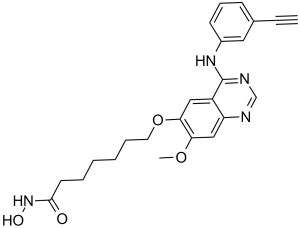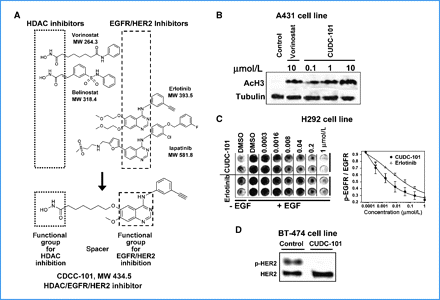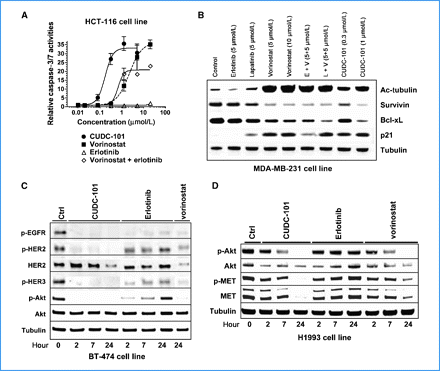This product is for research use only, not for human use. We do not sell to patients.

| Size | Price | Stock |
|---|---|---|
| 5mg | $65 | In Stock |
| 10mg | $90 | In Stock |
| 25mg | $150 | In Stock |
| 50mg | $210 | In Stock |
| 100mg | $380 | In Stock |
| 250mg | $750 | In Stock |
| 500mg | $1150 | In Stock |
Cat #: V0277 CAS #: 1012054-59-9 Purity ≥ 98%
Description: CUDC-101 is a novel, potent and multi-targeted histone deacetylase (HDAC) inhibitor with potential anticancer activity. It also inhibits EGFR and HER2 with IC50s of 4.4 nM, 2.4 nM, and 15.7 nM.
Publications Citing InvivoChem Products
Product Promise

- Physicochemical and Storage Information
- Protocol
- Related Biological Data
- Stock Solution Preparation
- Quality Control Documentation
| Molecular Weight (MW) | 434.49 |
|---|---|
| Molecular Formula | C24H26N4O4 |
| CAS No. | 1012054-59-9 |
| Storage | -20℃ for 3 years in powder form |
| -80℃ for 2 years in solvent | |
| Solubility In Vitro | DMSO: 20 mg/mL (46.0 mM) |
| Water: <1 mg/mL | |
| Ethanol: <1 mg/mL | |
| Solubility In Vivo | 15% Captisol: 30 mg/mL |
| Synonyms | CUDC-101; CUDC 101; CUDC101 Chemical Name: 7-(4-(3-ethynylphenylamino)-7-methoxyquinazolin-6-yloxy)-N-hydroxyheptanamide SMILES Code: O=C(NO)CCCCCCOC1=CC2=C(NC3=CC=CC(C#C)=C3)N=CN=C2C=C1OC |
| Protocol | In Vitro | In vitro activity: Specific for class I and class II HDACs, CUDC-101 does not inhibit class III Sir-type HDACs. CUDC-101 displays weak activity against other protein kinases including KDR/VEGFR2, Lyn, Lck, Abl-1, FGFR-2, Flt-3, and Ret with IC50 of 0.85 μM, 0.84 μM, 5.91 μM, 2.89 μM, 3.43 μM, 1.5 μM, abd 3.2 μM, respectively. CUDC-101 displays broad antiproliferative activity in many human cancer cell types with IC50 of 0.04-0.80 μM, exhibiting a higher potency than erlotinib, lapatinib, and combinations of vorinostat with either erlotinib or lapatinib in most cases. CUDC-101 potently inhibits lapatinib- and erlotinib-resistant cancer cell lines. CUDC-101 inhibits the erlotinib-resistant EGFR mutant T790M although its effects are incomplete with an Amax of ~60% of peak enzyme activity after inhibition. CUDC-101 treatment increases the acetylation of histone H3 and H4, as well as the acetylation of non-histone substrates of HDAC such as p53 and α-tubulin, in a dose-dependant manner in various cancer cell lines. CUDC-101 also suppresses HER3 expression, Met amplification, and AKT reactivation in tumor cells. Kinase Assay: The activities of Class I and II HDACs are assessed using the Biomol Color de Lys system. Briefly, HeLa cell nuclear extracts are used as a source of HDACs. Different concentrations of CUDC-101 are added to HeLa cell nuclear extracts in the presence of a colorimetric artificial substrate. Developer is added at the end of the assay and enzyme activity is measured in the Wallac Victor II 1420 microplate reader at 405 nM. EGFR and HER2 kinase activity are measured using HTScan EGF receptor and HER2 kinase assay kits. Briefly, the GST-EGFR fusion protein is incubated with synthetic biotinylated peptide substrate and varying concentrations of CUDC-101 in the presence of 400 mM ATP. Phosphorylated substrate is captured with strapavidin-coated 96-well plates. The level of phosphorylation is monitored by antiphospho-tyrosine- and europium-labeled secondary antibodies. The enhancement solution is added at the end of the assay and enzyme activity is measured in the Wallac Victor II 1420 microplate reader at 615 nM. Cell Assay: Cancer cell lines (HCC827, H358, H460, HepG2, Hep3B2, Sk-Hep-1, Capan1, BxPc3, MCF-7, MDA-MB-231, and Sk-Br-3) are plated at 5000 to 10000 cells per well in 96-well flatbottomed plates with varying concentrations of CUDC-101. The cells are incubated with CUDC-101 for 72 hours in the presence of 0.5% of fetal bovine serum. Growth inhibition is assessed by an adenosine triphosphate (ATP) content assay using the Perkin-Elmer ATPlite kit. Apoptosis is routinely assessed by measuring the activities of Caspase-3 and -7 using Apo-ONE Homogeneous Assay Kit. |
|---|---|---|
| In Vivo | Administration of CUDC-101 at 120 mg/kg/day induces tumor regression in the Hep-G2 liver cancer model, which is more efficacious than that of erlotinib at its maximum tolerated dose (25 mg/kg/day) and vorinostat at an equimolar concentration dose (72 mg/kg/day). CUDC-101 inhibits the growth of erlotinib-sensitive H358 NSCLC xenografts in a dose-dependent manner. CUDC-101 also shows potent inhibition of tumor growth in the erlotinib-resistant A549 NSCLC xenograft model. CUDC-101 produces significant tumor regression in the lapatinib-resistant, HER2-negative, EGFR-overexpressing MDA-MB-468 breast cancer model and the EGFR-overexpressing CAL-27 head and neck squamous cell carcinoma (HNSCC) model. Additionally, CUDC-101 inhibits tumor growth in the K-ras mutant HCT116 colorectal and EGFR/HER2 (neu)-expressing HPAC pancreatic cancer models. | |
| Animal model | Female athymic mice (nude nu/nu CD-1) inoculated with Hep-G2, H358, A549, MDA-MB468, HCT116, CAL-27, HepG2, or HPAC |
| Solvent volume to be added | Mass (the weight of a compound) | |||
|---|---|---|---|---|
| Mother liquor concentration | 1mg | 5mg | 10mg | 20mg |
| 1mM | 2.3015 mL | 11.5077 mL | 23.0155 mL | 46.0310 mL |
| 5mM | 0.4603 mL | 2.3015 mL | 4.6031 mL | 9.2062 mL |
| 10mM | 0.2302 mL | 1.1508 mL | 2.3015 mL | 4.6031 mL |
| 20mM | 0.1151 mL | 0.5754 mL | 1.1508 mL | 2.3015 mL |
This equation is commonly abbreviated as: C1 V1 = C2 V2
- (1) Please be sure that the solution is clear before the addition of next solvent. Dissolution methods like vortex, ultrasound or warming and heat may be used to aid dissolving.
- (2) Be sure to add the solvent(s) in order.







































